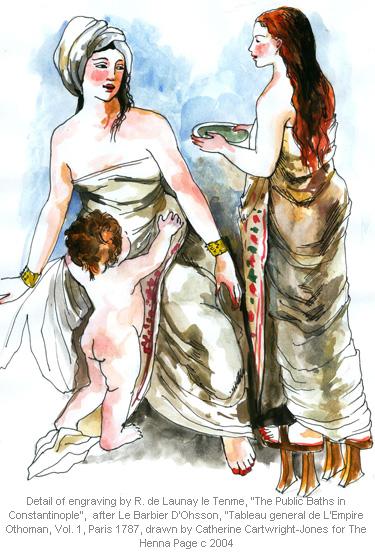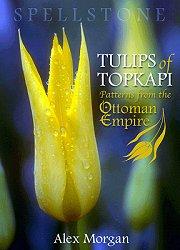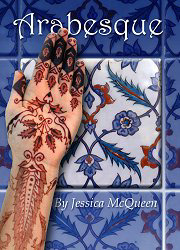|
Ottoman Hamam Catherine Cartwright-Jones © 2004  Bassano da Zara, in I Costumi et I
modi particolari de las vita de Turchi, 1545, wrote that Ottoman
women
hennaed themselves during their visits to the hamam, the public
baths. Paintings of the interior of the hamams often show women
carrying, offering, and putting their hands in wide, flat bowls of
henna. A slave brings henna to her mistress in the picture above,
drawn from a detail of The Public
Baths in Constantinople, by R. de Launay le Tenme after a
painting in Le Barbier D'Ohsson's Tableau general de L'Empire Othoman,
Vol. 1, published in Paris in 1787.
A visit to the hamam was not only a physical necessity, but a religious obligation, and one of the few times a woman’s husband would permit her a day out of the house. A woman was required to bathe completely after her menstrual cycle, so unless a husband was wealthy enough to build a private hamam for his wives, he would have to let them go to the bath. Evliya Celebi, in the 17th century, estimated Istanbul had over 4000 public baths. The hamam was a highly social place, where women carried on their relationships with other women, sometimes brokering marriage arrangements as they could see daughters entering puberty, spreading gossip when others became pregnant or not, and occasionally getting into screaming fights, complete with throwing henna bowls. Because women always had to go to the hamam after a menstrual cycle, birth or miscarriage, every woman knew every other woman’s business! Women mixed their henna the day before going to the hamam, and one of the accompanying servants carried it in a bowl to the bath. Other servants carried fruit, drinks, clean clothing, towels, combs, other cosmetics and a mirror, even a towel and pillows. A woman had high pattens (the high wooden platform shoes as seen in the illustration above) to keep her out of the ever-present puddles and muck on the bathhouse floor. These pattens were bridal gifts, and often made of fine wood, carved and inlaid. Women also hennaed their hair at the hamam, and wrapped it in “henna towels” with embroidered or crocheted edges. They had larger elaborate towels to step from their bath to the next room. The towels, combs, mirrors, and other bathing necessities were part of a husband’s bridal gift to his wife, and were an important part of her “bridal hamam”. Brides had an elaborate bathing party before their wedding, with musicians, dancers, and their bridal henna. Da Zara and Nicolas de Nicolay (1551) record that fashionable 16th century Ottoman Turkish women dyed their hair black with henna and indigo They dyed their eyebrows black with indigo or rastik, often connecting them across the brow. Aging women dyed their gray hair golden red with henna. They applied kohl to their eyes Women removed body and pubic hair by sugaring, or with a caustic paste followed by scraping with the sharp edge of a shell. The caustic depilatories dissolved hair, but also dissolved skin, especially in tender genital areas. . Henna soothed the vulva after the depilatory or sugaring. The caustic also made the skin very alkaline prior to henna application, which altered the henna/skin chemistry. Women applied the henna “four fingers breadth above the vulva”. A woman was not completely clean until all her hair had been removed, so she required help from another person. Many women became more than friends while tending each other’s purity. Homosociality often evolved into homoerotic activity, especially if arranged marriages were less satisfactory than hoped for. Marriages were often arranged for the financial benefit of a family, assuming that the bride would find some way to cope. Hussein Fazil Enderuni’s Women’s Bath from the Zanan-Name, 18th century, (Istanbul University Library), http://www.tuerkenbeute.de/window/illustration/B7-4FrauBad00il4_02_de.php , clearly shows two women with their hands in a henna bowl, and one applying henna to soothe her vulva. An attendant helps another woman henna her hair, and others carry bowls of henna and other bath articles. The baths had men’s and women’s days, or men's and women’s hours, because sexually mature married honorable women were not to be seen by men other than their husbands. Women took their very young male and female children to the hamam, though when the male children matured, they were no longer permitted, and were left with hungry, beautiful memories of what the women’s world and women’s love must be like. http://www.webdelsol.com/Del_Sol_Review/epicks2/farhi.htm Da Zara gives the Turkish pronunciation of henna in 1545 as Chna’, similar to the present Turkish pronunciation of Kina’ (accent on the second syllable). Though da Zara observed that henna was in the bath functioned as a deodorant, it may have been more accurate to say that henna can deter some bacteria, which often turn perspiration foul-smelling, rather than being an antiperspirant. Ottoman women used henna generously, much of which was produced in southern Iran and Egypt. In the late 19th century, the women of the two major cities, Istanbul and Smyrna, used an estimated 15,000 pounds of henna annually. http://www.hennaforhair.com/history/19thc.html Web resources for Henna and the Hamam in Turkey http://www.allaboutturkey.com/hamam.htm http://sircasaray.turkiye.org/anadolu/bath.html http://www.mymerhaba.com/en/main/content.asp_Q_id_E_154 http://www.melitour.com/turkbath1.htm http://www.kultur.gov.tr/portal/sanat_en.asp?belgeno=8729 http://www.victorianturkishbath.org/2HISTORY/AtoZHist/HotAir/pix/Pattens_w.htm http://www.victorianturkishbath.org/3TOPICS/AtoZArts/PowlettSF.htm References: Akurgal, E. The Art and Architecture of Turkey Rizzoli, 1980 Atil, E. The Age of Sultan Suleyman the Magnificent Harry N. Abrams, Inc., New York Barber, N. "The Sultans" Simon and Schuster, New York, 1973 "Codex Vindobonensis" 1590 Croutier, Alev Lytle “Harem: The World Behind the Veil” Abbeville Press 1989 da Zara, Bassano “I Costumi et I modi particolari de las vita de Turchi” 1545 Penzer, N. M. "The Harem" Bookplan, 1936 Wheatcroft, A. The Ottomans Viking, 1993 
 Alex Morgan's Tulips of Topkapi and Jessica McQueen's Arabesque have beautiful henna patterns adapted from Ottoman art! Available through TapDancing Lizard The Henna Page Main Index http://www.hennapage.com/henna/mainindex.html *"Henna,
the
Joyous Body Art"
the Encyclopedia of Henna Catherine Cartwright-Jones © 2000 registered with the US Library of Congress TXu 952-968 |